|
|

|
|

Components | Non Groupo Component Discussions
Over the years I have gotten a number of letters and calls about the comparisons between the "Big Three" component manufacturers' product lines. Of course there has been a war between these companies and their adherents for years, but at this time, the battle lines are more stable than ever because of a relative equity in their products. The pricing issues vary with exchange rates, but I can discuss the actual products' advantages and disadvantages.
As I said, the battle lines are quite stable at this time. All three companies: Campagnolo, Shimano and SRAM, make excellent products and within  each of the groupos' price ranges, they represent excellent quality and value. I am glad to see it. Competition is always good (at least for consumers). each of the groupos' price ranges, they represent excellent quality and value. I am glad to see it. Competition is always good (at least for consumers).
I'm going to look at the areas that these companies' component offerings are DIFFERENT from each other to give you a better idea of which might work best for you. My hope is that with the information I give here, your choices can be boiled down more easily.
- CONTROL LEVERS
All Campagnolo control levers, whether mechanical or electronic, operate with a shifting paddle behind the brake lever and a thumb shifter on the inside face of each control lever. Mechanical shifting one direction is done by moving the paddle inward by one, two or three clicks at a time. Shifting the other direction is done by pushing down on the thumb lever up to seven clicks at once. Campagnolo's electronic shifting is the same except that the paddle only moves one click. Shimano's mechanical shifting is accomplished by either pushing the BRAKE lever inwards or by pushing the inner paddle inwards. Their electronic shifting is similar except that instead of moving levers, a rider simply pushes what appear to be levers, but which are actually buttons. SRAM shifting is done only by pushing the shifting paddle inwards. With their mechanical shifting, pressing only a short distance on the shifting paddle will make a shift in one direction while pushing the paddle farther will shift in the other direction. SRAM's E-tap (electronic) system requires the rider to really change the way they accomplish shifts. The right paddle shifts down, the left paddle shifts up and both paddles together shift the front derailleur to the position that it is not currently in. It sounds a bit complicated, but all of the systems become intuitive quite quickly and there is no particular advantage to any one over the others. At this time, none of the higher end systems allow for triple gearing. If you need control levers that offer shifting with less force required, electronic shifting is the way to go. Instead of your fingers forcing a derailleur to move via a derailleur cable, you are shifting by simply tapping a button. Also, if you have small hands and have difficulty operating brake levers, both SRAM's and Shimano's control levers have micro-adjustable lever stops which allow you to significantly shorten the reach from bar to lever.
- BOTTOM BRACKET AND SPINDLE SYSTEMS
All of the bottom bracket systems used on our bicycles now are of the outboard bearing type. The bearing cups screw onto the bottom bracket shell and the bearings remain outside of the shell. This design creates a light, stiff and very easily serviced system that is very inexpensive to repair. The way that each of the companies have decided to design the specifics of how their bearings are loaded are quite different, but none of these differences matter to the customer. All good stuff.
- CASSETTES
All of the higher end groups from the big three use 11 speed cassettes. Cassettes by Shimano and SRAM are completely interchangeable. The spline patterns and cog spacing are exactly the same. Although Campagnolo's cassette spacing is technically different, they are so close to Shimano's and SRAM's that they are effectively the same. The Campy cassette body interface (or splines) is different from the others so they can not be swapped onto Shimano body hubs, but they will shift properly in a Shimano or SRAM equipped bike. Therefore, there is nothing preventing you from installing a SRAM cassette on a Shimano or Campy equipped bike or the other way around. A wide range of cassette ratios are available in both formats, but the Shimano/SRAM spec. offers a bit more range and variability mostly because both companies take a slightly different approach to gear ratios.
- CHAINS
As with cassettes, SRAM, Shimano and Campagnolo chains are designed for their eleven speed drive trains. Campagnolo chains require that the individual installing the chain use a special, and expensive Campy chain tool. Aside from that, the Campagnolo chains are excellent, quiet, strong and long lasting. Once a Campagnolo chain has been "broken" or removed from the bicycle, they must NOT be reassembled and must be thrown out. SRAM and Shimano chains are well designed and manufactured and do not require a special chain tool to assemble. Once removed from a bicycle, Shimano and SRAM chains can be reassembled but it is always best to replace them. All three companies' chains can be used with the others' drive trains.
- DERAILLEURS
All high end derailleurs work by the same principals. Their geometries differ and some of the specific ways that they attempt to improve shifting performance varies from one manufacturer to another, but they all work wonderfully once set up properly. Campagnolo's standard rear derailleurs will handle up to a 29 rear cassette while Shimano's and SRAM's handle up to a 28. Both SRAM and Shimano make longer cage rear derailleurs which handle up to 32 teeth. Although all three companies' front derailleurs shift somewhat differently, they all do a great job.
- BRAKE CALIPERS
All three companies make excellent brakes. Shimano's tend to have the most raw stopping power while Campagnolo brakes have the edge in feedback feel.
Return to Top
HEADSETS: Chris King- The highest quality made, beautiful, longest lasting, period. No point in mentioning any others.
SEAT POSTS: In reality, all they do is keep the saddle off the top tube, and they all work pretty much as they are intended. From a coolness perspective, Bold posts are at the top of the heap. The Bold custom drawn and welded titanium units are as exclusive as they get. The most important design consideration when looking at posts beyond the diameter is the setback. Setback is the distance behind the centerline of the post shaft to the centerline of the saddle rail clamp. Standard setback is around 2.0 to 2.5 cm. If you need setback to get your saddle far enough back, be sure not to get a "center clamp" post. Finally, keep in mind that many posts are not actually the diameter that they are supposed to be. Many posts marked 27.2mm are actually 27.05mm to 27.15mm. That may sound like nit picking, but anything under about 27.18mm will cause problems. Check your posts... For some reason, almost all 31.6mm posts are actually 31.6mm. So for our titanium frames which use that size, you shouldn't need to worry.
STEMS:Most of the stems now on the market work just fine. There have been some intermittent problems with a couple of the lighter ones that I don't want to get into here for a number of reasons. During your fitting and ordering process, I will be sure to prevent you from ordering a stem that we do not trust. The decision of which stem to order is primarily one of fitting geometry. We need to make sure that the stem we get for you is of the correct length and angle. There is no particular reason to use stems and bars from the same manufacturer. For example, using an ITM stem with a TTT bar is fine.
HANDLEBARS: There are a huge variety of bars on the market. Weight should NOT be your first concern. Fit is much more important. The three critical dimensions that vary between bars are width, reach and drop. Because bar reach and drop differ so much from bar to bar, they affect the fit of the bike correspondingly. The choice of a handlebar must be made during the fitting process.' The wrong bar can ruin the fit and feel of an otherwise properly designed frame.
SADDLES: REMEMBER THIS:"Shape is everything and texture is nothing." If you seem to need a very cushy saddle to be comfortable, then you are on the wrong saddle. The biggest annoyance in choosing a saddle is that you can't tell if a saddle fits properly without riding on it for a while. An expensive proposition. For those who have found a saddle that works for them ... "if it ain't broke, don't fix it." If you have not found a saddle that works, we may be able to make a few suggestions for you during the fitting process. There is a reason that there are so many saddles on the market... there are so many different pelvic shapes out there.
RIMS: This is a very complicated category to discuss. There are a huge number of rims and pre built wheels on the market so I will limit myself to discussing the most common parts on the market.
- TUBULAR: At this point, for practical purposes, if you are looking for unassembled rims, you are limited to the Mavic Reflex, American Classic Classics Tubular and HED Ardennes tubular rims. The HED rims will last most folks many years. They are the toughest tubular rims on the market, but somewhat pricy. In fact, all three are excellent rims, semi box shape, very strong and comfortable.
- CLINCHER: for general purpose training, racing and light touring, the Mavic Open Pro is not only the most common, but also, along with the HED Ardennes clincher, the best rim on the market. For loaded touring, tandems and for heavier and taller riders, you may want to consider the Mavic 719.
- WHEELS: Ksyrium- Super strong, fairly light, semi aero, very cool looking. Available in a number of price ranges depending on design and component specifics. The Ksyrium Elite is the most comfortable and the best all purpose of the Ksyrium wheels while the SSC is the stiffest and lightest this side of the PRO Carbon. Zipp; 303 tubular- Super light. These are my use-anywhere race wheels. Very reliable and aero but not as comfortable as a box section rimed wheel is. 404 clincher - deeper section than the 303 but quite light and very strong. Not very good in cross winds but ideal time trial wheels on calm days. American Classic Sprint 350; pretty much the most "fun" clincher wheel on the market. These wheels feel the best of all pre-built clincher wheels. They spin up super fast and hold up pretty much like iron even though they are quite light. The lightest clincher wheel set are the American Classic "Road Tubeless." I've beaten the crap out of them and they just keep on going. But I only weigh 150. There are lots of other wheels out there but I have to quit somewhere. The above list covers a few of wheel and rim choices that make sense. During a fitting process we can discuss others you may be interested in.
TIRES
First, Tubular v. Clincher. Good tubulars are better than the best clinchers, but unless you already use tubulars or are willing to go through a pretty steep learning curve in tubular use and lore, you should probably stick with clinchers. I use tubulars because I always have and they are still better tires than clinchers, but keep in mind that I have been using them for over 40 years. I only ride Vittoria Corsa or Pave tires, but tubulars from Veloflex, Schwalbe, Clement and Continental are excellent as well. We offer the best clincher tires on the market. They each have their own strengths. The highest performance competition clinchers are the Vittoria Open CXs. Tough enough for racing, but too pricy for day to day use. The best general purpose high end clinchers are the Vredestein Tri-Comps and Fortezzas. They wear well, are very comfortable and their handling is among the best. For slightly better durability but less comfort the old Conti Grand Prix range of tires is still among the best. In tubeless tires, the best performance tire is either the IRC RBCC or the Schwalbe ONE. Both offer excellent rides, good durability and relative ease of mounting. If pure cornering performance is critical, the RBCC has the edge. For a larger and more durable tire, the Hutchinson Sector 28 may be your best bet. It wears like iron, but tends to ride like it as well.
PEDALS
It is helpful to divide pedals into three categories; Floating, fixed and walkable. The floating road pedals include pedals like the Speedplays, Times, Be-Bops, etc. The fixed pedals include Look, Campagnolo, Keywin, Shimano, etc. and the walkable pedals include all the off-road types. I call the fixed pedals by that name because they are all self centering to various degrees and therefore, their floating features have little orthopedic value. The one exception I can think of is the Keywin, which I will get into. Your choice of pedal usually comes down to what you are most comfortable with unless there is an orthopedic requirement that forces you to use floating pedals.
- FLOATING: Some riders simply cannot find a cleat position which allows them to ride without knee pain. Frequently a floating pedal solves this problem since in many cases, their pelvic and leg structures require different foot rotations during different parts of the pedal stroke. These riders need floating pedals. Speedplays have a couple of features that are helpful to many riders. They are the lightest on the market, offer the best cornering clearance, smallest ball-of-foot to spindle measurement, are bombproof simple and are the easiest pedals anywhere to get into and out of.
- FIXED: Most of the fixed pedals work pretty much the same. The lightest fixed pedal is the Keywin. In its as-delivered condition, it is a fixed pedal, but with a minute's work, it can become a floating type. They are well made, mechanically simple and very tough.
- WALKABLE: Shimano owns most of the walkable pedal market. They work well and they are pretty much ubiquitous. For walkable road riding, they are as good a choice as any. If you want a full floating walkable pedal, your pedal is either the Speedplay "Frog" or the Speedplay "SYZR." Just as full floating as the Speedplay "X"series pedals but with a walkable recessed cleat. Other "walkable" or off road pedals we think well of are made by Crank Brothers, Time and Look.
Return to Top
|
|
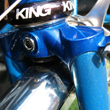
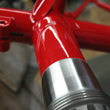
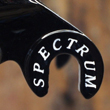
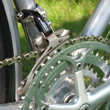
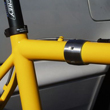
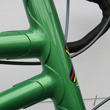
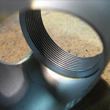








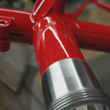
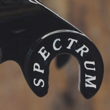
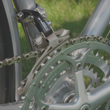
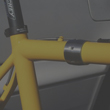


|
|























